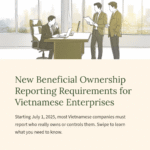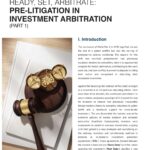To read or download the article, please click the following link.
I. INTRODUCTION
As the world works to fight climate change, carbon credits have become an important tool to control and reduce greenhouse gases. A carbon credit allows the release of one ton of carbon dioxide (CO2) or other greenhouse gases equal to one ton of CO2. Most countries and businesses use carbon credits to help reach the goal of zero net emissions by 2050.
Carbon credits do more than just help the environment. They also create new business chances, especially for industries that release a lot of greenhouse gases, like power plants, steel factories, and cement makers. The carbon credit market is growing fast, particularly in places with strict rules about greenhouse gas emissions, such as the European Union, Japan, and South Korea. These markets let businesses buy and sell carbon credits to meet emission rules and save money.
Vietnam is starting to create policies for carbon credits. The country plans to have its own carbon market working by 2028. While this market is new in Vietnam, it has great potential. Vietnam has many natural resources and projects in areas like renewable energy, farming, and nature protection.
The carbon credit market offers economic opportunities for businesses and helps support environmental projects. Companies can make money by selling carbon credits when they work on projects that reduce emissions, like planting forests or developing renewable energy. This creates opportunities for businesses and helps the whole economy move towards a greener way of growing.
II. BASIC CONCEPTS OF CARBON CREDITS
A carbon credit is like a special permit that can be bought and sold. It gives the owner the right to release one ton of carbon dioxide (CO2) or an equal amount of other greenhouse gases into the air. Carbon credits are a tool to help countries and businesses lower their greenhouse gas emissions by trading these credits in a carbon market.
Companies or groups that work on projects to reduce emissions can earn carbon credits. These projects might include using renewable energy, protecting forests, or developing clean technology. The number of credits they get depends on how much they reduce greenhouse gases. They can then sell these credits to others in the international market, often using a system called “cap-and-trade.”
The idea of carbon credits started with the Kyoto Protocol in 1997. This was one of the first international agreements to encourage countries to lower their CO2 emissions. As more programs like the Clean Development Mechanism (CDM) were created, carbon credits became an important part of how many countries manage environmental issues.
There are two main types of carbon credit markets:
- Compliance Market: These markets are controlled by governments. They apply to industries that must stay within certain limits for greenhouse gas emissions set by the government. If a business goes over this limit, it might face penalties or have to buy extra carbon credits from other businesses that have extra.
- Voluntary Market: This market is optional. Companies and individuals can choose to buy and sell carbon credits here to meet their own goals for reducing emissions, even if they’re not required to do so.
III. CARBON CREDIT MARKET
1. Global Carbon Credit Market
The global market for carbon credits is growing fast. More countries and companies want to buy carbon credits to reach their goals of balancing out their emissions (called Net Zero). These credits come from projects that reduce emissions, like planting forests, protecting land, and creating clean energy. In 2022, forestry and land use projects were the biggest part of the market. Renewable energy credits, while cheaper, were still traded a lot.
Many things affect the prices and how much carbon credits are traded. These include how good the credits are, what kind of project they’re from, and where the project is. Credits that do extra good things, like helping wildlife or local communities, usually cost more. Also, when rules are unclear or the market isn’t very open, prices can change a lot.
The carbon credit market gives businesses and governments a chance to lower their greenhouse gases and make money from environmental projects. But there are also some problems:
- Legal Issues: One big problem is that different countries have different rules. This makes it hard to trade between countries and limits what projects can do.
- Money and Technical Problems: Starting carbon credit projects costs a lot of money. Checking these projects needs advanced technology and experts. The complex financial setup, high starting costs, and long wait for profit are challenging for many businesses.
- Quality of Credits: People worry about how good carbon credits really are. Credits need to be clear about what they do and actually reduce emissions. They need to be carefully checked by outside experts. There’s also concern about “greenwashing,” where things seem more environmentally friendly than they really are.
2. Carbon Credit Market in Vietnam
Vietnam’s carbon credit market is just starting out. It has a lot of potential but also faces challenges. The country has some laws about carbon credits, but they’re not fully working yet. The government is still setting up the rules and systems to get the market fully running by 2028.
In Vietnam, carbon credits come from projects that lower emissions, mostly in clean energy, forests, and farming. Big companies like Vinamilk and Loc Troi are working on these projects. They’re trying to lower their greenhouse gases and might sell carbon credits in Vietnam and other countries.
Vietnam has sold some carbon credits to other countries, but they don’t cost as much as in developed countries yet. Right now, they sell for about 5 to 10 US dollars each. But experts think the price will go up when Vietnam finishes its rules and connects with big markets like Europe and Japan.
Vietnam faces some big challenges in developing its carbon credit market. It needs better ways to measure, report, and check emissions. It also needs to connect better with international markets. But this also gives businesses a big chance, especially in farming and clean energy. Vietnam could create many projects in planting forests and low-carbon farming.
IV. INTERNATIONAL LEGAL FRAMEWORK ON CARBON CREDIT MARKET
Carbon credits are an important tool that helps countries and businesses lower their greenhouse gas emissions. They support international agreements like the United Nations Framework Convention on Climate Change (UNFCCC), the Kyoto Protocol, and the Paris Agreement. Many countries and big regions have set up systems and markets to trade carbon credits. This allows businesses to meet their emission goals and also make money by trading these credits.
As we mentioned before, there are two types of global carbon credit markets: mandatory and voluntary. The mandatory market has strict rules set by international treaties and government regulations. It mainly applies to industries that release a lot of emissions. A good example is the European Union Emissions Trading System (EU ETS). In this system, businesses must stay within certain emission limits or buy credits to make up for extra emissions.
To make sure carbon credits are honest and clear, there are international standards. Some of these include: Gold Standard, VERRA’s Verified Carbon Standard (VCS), ART/TREES Standard, PLAN VIVO Standard, Climate, Community & Biodiversity (CCB) Standard, etc.
These standards can be used for many different types of projects. Common projects that create carbon credits include developing renewable energy, planting new forests, and protecting existing forests. These projects can be certified under these standards.
The price of carbon credits can be very different depending on what kind of project they come from and which standard is used. For example, credits from renewable energy projects usually cost much less than credits from projects that protect forests or support sustainable development.
V. LEGAL REGULATIONS IN VIETNAM ON CARBON CREDIT MARKET
This section covers important legal issues about the carbon credit market in Vietnam. In Vietnam, this is also called the “domestic carbon market,” as mentioned in Decree 06/2022/NĐ-CP.
1. Legal Framework
Vietnam has created specific laws to control carbon credit activities. The most important document is Decree 06/2022/NĐ-CP. This decree sets rules for reducing greenhouse gases and protecting the ozone layer. It also establishes how the domestic carbon market will work. Businesses that release a lot of emissions will need to follow these rules to control and report their greenhouse gases.
According to Decree 06/2022/NĐ-CP, Vietnam’s carbon credit market will develop in two stages:
- Preparation Stage (until the end of 2027):
– Create and issue rules for managing carbon credits and trading emission allowances
– Set up a test system for trading carbon credits and offsetting emissions
– This includes checking and confirming carbon credits from projects that reduce emissions
- Official Operation Stage (from 2028):
– Start an official carbon credit exchange
– Allow carbon credit trades between Vietnamese businesses
– Connect with international markets
Right now, the Vietnamese Government is working on a new draft decree. This will update Decree 06/2022/NĐ-CP to better fit current situations in Vietnam and around the world.
2. Definition of Domestic Carbon Market
Under current Vietnamese law, the domestic carbon market has two main parts:
- Greenhouse gas emission allowance trading: This lets organizations trade the right to release a certain amount of greenhouse gases, as allowed by law.
- Carbon credit trading: This involves buying and selling carbon credits. These credits can be used both in Vietnam and internationally.
It’s important to know that, according to Article 17.2(b) of Decree 06/2022/NĐ-CP, Vietnam will only officially start connecting and exchanging its carbon credits with regional and international carbon markets in 2028.
3. Participants in the Domestic Carbon Market
According to Vietnamese law, the domestic carbon market has specific types of participants:
- Facilities that release greenhouse gases: These are listed in Decision 01/2022/QĐ-TTg (which will be replaced by Decision 13/2024/QĐ-TTg starting October 1, 2024). These facilities must report their greenhouse gas emissions.
- Organizations involved in carbon credit trading and offsetting: This includes groups with projects related to carbon credit trading, both in Vietnam and internationally.
- Other organizations and individuals: This includes those who invest in or do business related to greenhouse gas emission allowances or carbon credits.
A new draft Decree to update Decree 06/2022/NĐ-CP gives more details about who can participate in different carbon market activities:
- For greenhouse gas emission allowance trading: Facilities that release greenhouse gases, have been given emission allowances, and must report their emissions.
- For carbon credit trading:
– Facilities that release greenhouse gases, have been given emission allowances, and must report their emissions.
– Organizations with projects involved in carbon credit trading or offsetting.
– Organizations and individuals that buy and sell carbon credits.
4. Allowances
In Vietnam’s domestic carbon market, there are two main types of allowances:
- Greenhouse gas emission allowances: The Law on Environmental Protection 2020 defines these as the amount of greenhouse gases a country, organization, or person can release in a certain time. It’s measured in tons of CO2 or its equivalent (tCO2e).
There aren’t yet official rules about these allowances. The plan is to first give allowances to big emitters in three areas: thermal power, iron and steel production, and cement production. One allowance will equal one ton of CO2.
- Carbon credits: While there aren’t specific rules about carbon credit allowances, these credits can be used to offset greenhouse gas emissions in the trading system. One carbon credit also equals one ton of CO2.
The draft Decree to update Decree 06/2022/NĐ-CP says that carbon credits traded in the domestic market must be for greenhouse gas reductions certified after January 1, 2021. Each credit represents a one-ton reduction in CO2 emissions.
5. Carbon Credit Issuing Entities
Right now, Vietnamese law doesn’t clearly state who can issue carbon credits. However, for a specific type called Certified Emission Reductions (CERs), the CDM Executive Board issues these for CDM projects.
The Draft Decree to update Decree 06/2022/NĐ-CP suggests that in the future, ministers from relevant government departments might issue carbon credits. This means carbon credits could be issued at the national level, with different ministries overseeing the process.
6. Auctioning, Transferring, Borrowing, and Offsetting Greenhouse Gas Emission Allowances
Under current Vietnamese law, facilities that release greenhouse gases can use several methods to manage their emission allowances:
- Auctioning: Facilities can bid to get more emission allowances on top of what they’re already given for the same time period.
- Transferring: Facilities can move unused allowances from one year to later years within the same time period.
- Borrowing: Facilities can borrow allowances from the next year to use earlier in the same time period. The law doesn’t clearly say who they borrow from, but it might be from the Ministry of Natural Resources and Environment (MONRE).
- Offsetting with carbon credits: Facilities can use carbon credits from trading and offsetting projects to make up for greenhouse gas emissions that go over their allowance. However, they can only use carbon credits for up to 10% of their total allowance.
Facilities that emit greenhouse gases should also know about these rules:
- MONRE can take back allowances if a facility stops operating, closes down, or goes bankrupt.
- Facilities are encouraged to give back allowances they don’t use.
- At the end of each time period, facilities must pay for any emissions that go over their allowance, even after using auctions, transfers, borrowing, and offsetting. The extra emissions will be taken off their allowance for the next time period.
The current law doesn’t say how much facilities will have to pay for excess emissions. These specific rules are still being worked out.
The Draft Decree to update Decree 06/2022/NĐ-CP adds an important point: if a facility’s reported emissions are lower than what’s verified, they must buy more allowances through auctions or buy more carbon credits from relevant projects. This is important to remember when participating in the carbon market.
7. Carbon Credit Trading and Offsetting Mechanism
Under Vietnamese law, the carbon credit trading and offsetting mechanism allows organizations to register and carry out programs and projects that reduce greenhouse gas emissions. These projects can then generate carbon credits using methods recognized internationally or by Vietnam.
Various groups can participate in this mechanism:
- Organizations, households, individuals, and communities that manage, lease, or own land for forests (planting, restoring, or developing forests).
- Facilities that emit greenhouse gases.
- Vietnamese organizations that want to develop and run programs and projects under this mechanism in Vietnam.
- Foreign organizations that want to develop and run carbon offset projects in Vietnam.
The draft update to Decree 06/2022/NĐ-CP suggests that some Vietnamese ministries (like Industry and Trade, Transport, Agriculture and Rural Development, Natural Resources and Environment, and Construction) might also be allowed to participate.
To register a program or project under this mechanism, organizations need to follow these steps:
- Submit documents to the Ministry of Natural Resources and Environment (MONRE).
- If needed, add more information to the documents when MONRE asks.
- MONRE will review the documents, talking to other relevant agencies.
- If approved, the Minister of MONRE will issue a decision and notify the organization.
8. Forest Carbon Credits
Right now, Vietnam doesn’t have clear laws about forest carbon credits. However, these credits can be recognized for reducing emissions or absorbing 1 ton of CO2 (or its equivalent) through activities like:
- Stopping deforestation and forest damage.
- Managing forests sustainably.
- Conserving and increasing forest carbon storage.
- Protecting forests, helping forests regrow naturally, and planting new forests.
Several international standards can be used for forest carbon credits, though Vietnam hasn’t officially recognized these in its laws yet. These standards help ensure that forest carbon credits are reliable and meet international quality requirements.
9. Verification of Traded Carbon Credits and Greenhouse Gas Emission Allowances
To trade carbon credits or greenhouse gas emission allowances, organizations and individuals need to follow these steps:
- Submit an application: Send an application to verify the carbon credits or greenhouse gas emission allowances to the Ministry of Natural Resources and Environment. This is done through an online public service system.
- Wait for verification and certificate: The Ministry will check the application and issue a Certificate of Verification within 15 working days.
If you need to trade a specific number of carbon credits or emission allowances, you should apply for verification for that exact amount. The current law doesn’t clearly say if sellers need to update information on the carbon credit (like the amount of CO2 emitted) after selling it.
10. Trading Platform
According to Decree 06/2022/ND-CP, all transactions involving greenhouse gas emission allowances and carbon credits must happen on a carbon credit trading platform. However, Vietnam doesn’t have such a platform yet.
A carbon credit trading platform is a center where people can buy and sell carbon credits and emission allowances. It’s also where they can auction, borrow, return, and transfer emission allowances. This platform is important for making sure all transactions are clear and effective.
Different government departments have different jobs:
- Ministry of Finance: In charge of setting up and running the trading platform. They also make rules about how money is managed in the carbon market.
- Ministry of Natural Resources and Environment: Responsible for testing and then officially running the trading platform. The plan is to start setting up and testing in 2025, with official operations beginning in 2028.
On September 29, 2023, a company called ASEAN Carbon Credit Trading Platform Joint Stock Company (CCTPA) launched the first carbon credit trading platform in Vietnam. But since the official platform will be set up by the government, CCTPA’s platform might not be considered official under current laws.
The draft update to Decree 06/2022/ND-CP gives more details about how the trading platform will work:
- It will be officially called the Carbon Exchange.
- The Hanoi Stock Exchange (HNX) will handle domestic carbon trading.
- The Vietnam Securities Depository (VSDC) will handle registering, giving out codes, storing, clearing, and settling transactions for emission allowances and carbon credits.
- Trades will be made by matching buy and sell orders, following the rules of the stock exchange.
11. Tax
a) Corporate Income Tax (CIT)
Right now, it’s not clear if carbon credits and greenhouse gas emission quotas are the same as Certified Emission Reduction (CER) credits. CERs are issued by the CDM Executive Board for CDM projects, with each CER equal to one ton of CO2.
A CDM project uses new, advanced, and environmentally friendly technology to reduce greenhouse gas emissions. The CDM Executive Board, set up by countries in the Climate Convention, approves these projects.
For taxes:
- The first sale of CERs doesn’t have to pay CIT if the environmental authority approves it.
- Later sales of CERs pay 20% CIT.
For carbon credits and emission quotas, we’re not sure if they count as CERs. But a new draft law suggests that all sales of carbon credits might not have to pay CIT. This could make it easier for businesses to trade carbon credits.
b) Value Added Tax (VAT)
Right now, money from selling emission rights doesn’t have to pay VAT. Carbon credits and emission quotas might count as “emission rights,” so they probably don’t have to pay VAT either.
But be careful: selling voluntary emission reduction (VER) certificates still has to pay 10% VAT.
c) Personal Income Tax (PIT)
For PIT, the rules aren’t clear about money from selling carbon credits and emission quotas. We don’t know if this money is tax-free or how much tax it should pay if it isn’t. This kind of income isn’t clearly listed in the types of income that pay tax. So, we might need to wait for the tax authorities to explain more about how PIT works for these sales in the future.







